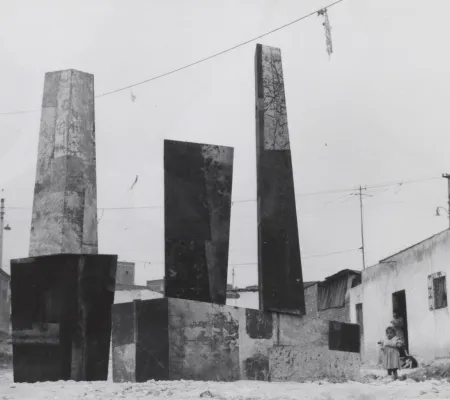Mathias Goeritz, Realization No. 3 (1959) on Jalapa Street, Mexico City, ca. 1960.
In the wake of World War II, Mathias Goeritz (1915–1990) applied his skills as a Berlin-trained art historian toward a career as an artist in Cold War Mexico. Employing tactics that included outsourcing labor to artisans, manipulating photographs, and distributing manifestos, Goeritz translated, synthesized, and inverted strains of modernism that were identified with Europe and the United States into concepts and forms that responded to local circumstances and concerns. In doing so, he highlighted the difference of his projects from those of his peers in Mexico, while also registering Mexico’s difference from the industrialized West.
In the late 1950s, Goeritz’s artistic practice took a radical turn. Abandoning the idealistic monumentality of his and Luis Barragán’s recently-completed Towers of Satellite City, Goeritz began producing his Messages and Realizations: abstract assemblages made from discarded construction materials, which he designed for export to New York and Paris. By strategically framing these missives from Mexico in artisanal and religious terms, he engaged dialectically both with the ethos of the so-called Mexican School of Painting, and with the commitments to technology and secularism espoused by some of his European peers.
Jennifer Josten is Assistant Professor in the Department of History of Art and Architecture at the University of Pittsburgh, where she holds a secondary appointment in Hispanic Languages and Literatures and is core faculty in the Center for Latin American Studies. Her book, Mathias Goeritz: Modernist Art and Architecture in Cold War Mexico, is forthcoming from Yale University Press in October 2018. Josten’s research on twentieth-century artistic exchanges between the Americas and Europe has also appeared in exhibition catalogues and anthologies including Found in Translation: Design in California and Mexico, 1915–1985, ed. Wendy Kaplan (Los Angeles: LACMA, 2017); Lucio Fontana: Ambienti/Environments, ed. Marina Pugliese, et. al. (Milan: Hangar Bicocca, 2017); Ida Rodríguez Prampolini: La crítica de arte en el siglo XX, ed. Cristóbal Andrés Jácome (Mexico City: IIE, UNAM, 2016); El retorno de la serpiente: Mathias Goeritz y la invención de la Arquitectura emocional, ed. Francisco Reyes Palma (Madrid: Museo Nacional Centro de Arte Reina Sofía, 2014); and Defying Stability: Artistic Processes in Mexico, 1952–1967, ed. Rita Eder (Mexico City: MUAC, UNAM, 2014).


